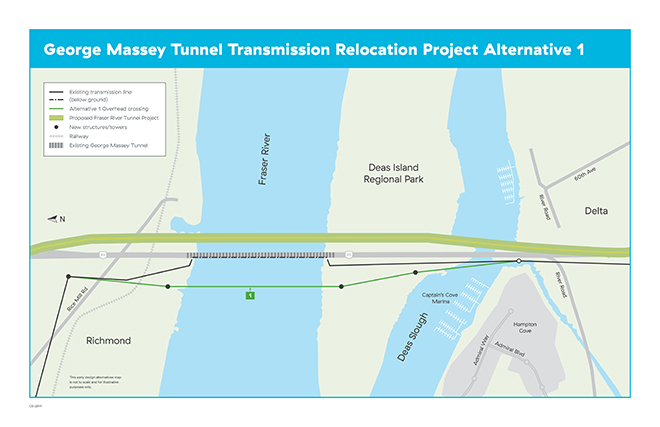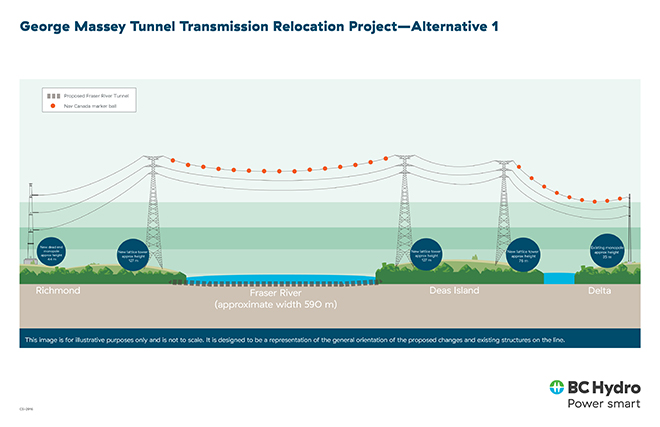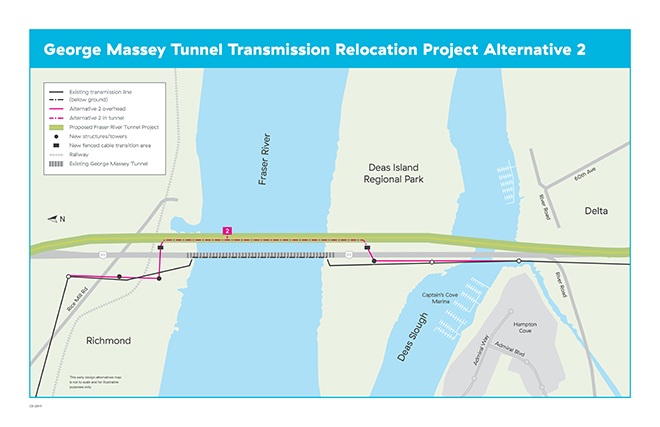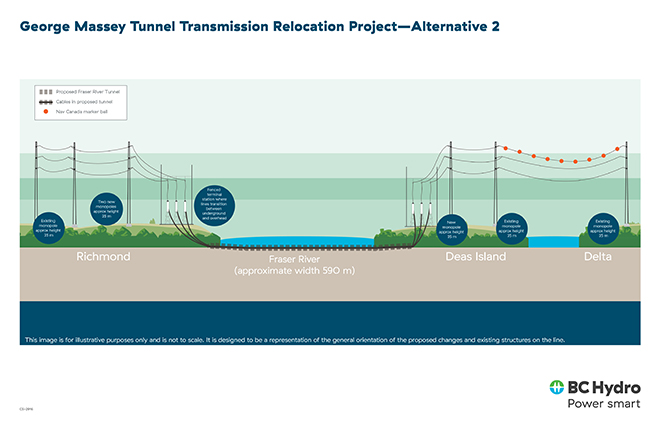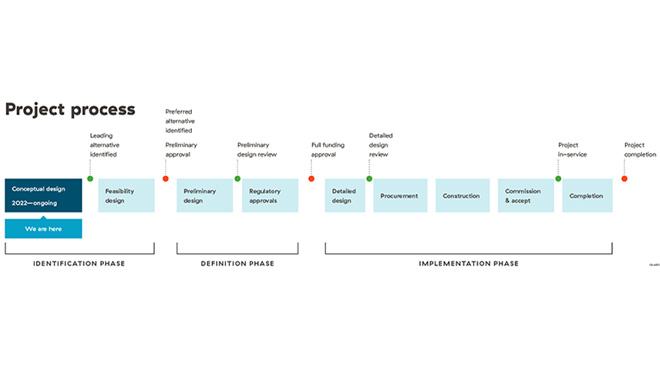George Massey Tunnel transmission relocation project
As a new tunnel is planned, a section of our power line needs to be relocated
The Government of B.C. is proposing to replace the existing four-lane George Massey Tunnel with a new, eight-lane immersed tube tunnel, and will decommission the existing tunnel once the new tunnel is in operation.
A section of one of our power lines crosses the Fraser River through the George Massey Tunnel so we need to relocate it before the tunnel is decommissioned.
What's new
October 2025
We've updated our project timeline. We've continued studying two alternatives to relocate this section of power line – one overhead alternative (Alternative 1) and one underground alternative (Alternative 2).
As the B.C. Government advances its tunnel design work, we're continuing to engage with the B.C. Government to determine the feasibility of Alternative 2.
We currently anticipate identifying a leading alternative by spring 2026.
The Government of B.C. is proposing to replace the existing four-lane George Massey Tunnel with a new, eight-lane immersed tube tunnel, and will decommission the existing tunnel once the new tunnel is in operation.
We operate a 12-kilometre, 230-kilovolt power line from Arnott Substation in Delta to Steveston Substation in Richmond, serving approximately 30,000 customers. Approximately 700 metres of this line is underground in the existing George Massey Tunnel. With the tunnel planned for decommissioning, we need to relocate this section of the power line across the Fraser River.
We're examining two alternatives to relocate a section of the existing power line that’s currently located underground in the George Massey Tunnel. We initially studied a third alternative – a separate underground line – but concluded the alternative wasn’t an acceptable solution due to high cost, and environmental and geotechnical risks.
Learn more about Alternatives 1 and 2 below.
This project is in an early stage, and the design for each alternative is conceptual and subject to change as the project advances.
We anticipate that this project will primarily take place within the existing Ministry of Transportation and Infrastructure (MOTI) right-of-way. This area has undergone significant industrial and agricultural development over the past 100 years. Initial studies have identified potential impacts from our two conceptual alternatives, which will be studied further, and appropriate mitigation measures will be developed and implemented.
Profile illustration
Select the illustration to view it at a larger size.
Technical details:
- Replaces seven existing approximately 38-metre steel monopoles with four new structures:
- Two new 127-metre steel lattice suspension towers to support the 760-metre power line crossing the river. Power line height requirements over navigable waters are determined by Transport Canada.
- One 76.6-metre steel lattice tower on Deas Island to support the power line.
- One 44-metre steel monopole in Richmond to support the power line.
- For aircraft safety, it will require 15 marker balls on the line across the river and nine on the line across Deas Slough.
Permits that may be required:
- An application for approval for Fraser River and Deas Slough (Canadian Navigable Waters Act).
- Other regulatory considerations may be added as the project advances.
Land use considerations:
- Will require temporary laydown areas on Deas Island Regional Park and in Richmond for construction, all within the MOTI right-of-way and on previously disturbed land.
- Public access to some areas of Deas Island and the Model Airplane Park in Richmond may be restricted during construction. There would be no effects once the project is complete.
Fish and fish habitat considerations:
- Potential for siltation in fish habitat during construction near the Airplane Park in Richmond. This would be mitigated as per environmental best management practices.
Vegetation and habitat considerations:
- Potential for vegetation removal in Deas Island Regional Park during ground improvements for structures that support the power line across the Fraser River. Vegetation removal activities would be done outside of the bird nesting window and follow best management practices.
Wildlife considerations:
- Potential collision risk with birds and bats. This risk can be mitigated through design.
Contaminated soils:
- No interaction is anticipated.
Visual quality:
- The new structures will cause a change to the visual landscape. The visibility of the structures may be mitigated by trees adjacent to the project area and by the see-through lattice design.
River access:
- Access from the study area to the Fraser River and Deas Slough may be temporarily affected during construction when installing the power lines.
Profile illustration
Select the illustration to view it at a larger size.
Technical details
- Replaces seven existing approximately 38-metre steel monopoles with five new structures:
- Three new 35-metre steel monopoles.
- Requires two 800-square-metre, above-ground terminal stations, with two 18-metre steel structures, where the line transitions from overhead to underground, one in Richmond and one on Deas Island.
Permits that may be required:
- A notification for Deas Slough (Canadian Navigable Waters Act).
- Other regulatory considerations may be added as the project advances.
Land use considerations:
- Will require temporary laydown areas in Richmond outside of the MOTI right-of-way, and on Deas Island for construction.
Fish and fish habitat considerations:
- No interaction is anticipated.
Vegetation and habitat considerations:
- No interaction is anticipated.
Wildlife considerations:
- May require nest protection during vegetation maintenance. This would be managed with best management practices.
Contaminated soils:
- Temporary interaction during construction of terminal structures and monopoles. Excavated soils would be tested for contamination and properly disposed.
Visual quality:
- No change to the visual landscape is anticipated.
River access:
- Access from the study area to Deas Slough may be temporarily affected during construction when installing the power lines
The George Massey Tunnel transmission relocation project is in its earliest days and a project timeline hasn't been established. We'll identify an estimated project timeline after a leading alternative has been identified in 2026.
Here are some of our project activities:
- Environment, archaeology, and engineering desktop studies – 2022 - 2025
- First Nations consultation and stakeholder engagement – ongoing
Thank you to those who joined our online open houses in January 2023, and took the time the complete our survey to learn more about the project and share feedback with us.
Here's a summary of what we heard.
George Massey Tunnel Transmission Relocation Project consultation summary report – August 2023 [PDF, 3.0 MB]
We'll be back for more engagement once we've identified a leading alternative for further study. In the meantime, if you have further questions or comments, or if you're part of a community group and would like us to provide you with a high-level overview of the project and the alternatives we're studying, please reach out to the project team at projects@bchydro.com.
Contact us
If you'd like to learn more about the project, please contact us at:
Email: projects@bchydro.com
Phone: 604 623 4472
Toll free: 1 866 647 3334
Sign up for updates
Receive updates and information about the George Massey Tunnel transmission replacement project.
